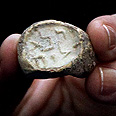
Clay seal indicative of Temple activity
Rare finding discovered under Jerusalem's Old City appears to be linked to religious rituals practiced at Jewish Temple 2,000 years ago
The coin-sized seal found near the Jewish holy site at the Western Wall bears two Aramaic words meaning "pure for God."
Archaeologist Ronny Reich of Haifa University said it dates from between the 1st century B.C. to 70 A.D. – the year Roman forces put down a Jewish revolt and destroyed the second of the two biblical Jewish temples.
The find marks the first discovery of a written seal from that period of Jerusalem's history, and appeared to be a unique physical artifact from ritual practice in the Temple, he said.

Artifact bears two Aramaic words meaning 'pure for God' (Photo: Gil Yohanan)
Very few artifacts linked to the Temple have been discovered so far. The site of the Temple itself – the enclosure known to Jews as the Temple Mount and to Muslims as the Noble Sanctuary – remains off-limits to archaeologists because of its religious and political sensitivity.
Archaeologists say the seal was likely used by Temple officials approving an object for ritual use – oil, perhaps, or an animal intended for sacrifice. Materials used by Temple priests had to meet stringent purity guidelines stipulated in detail in Jewish legal texts, which also mention the use of such seals.
The find, Reich said, is "the first time an indication was brought by archaeology about activities in the Temple Mount - the religious activities of buying and offering and giving to the Temple itself."
'Similar to what we see described in Mishna'
The site where the seal was found is on the route of a main street that ran through ancient Jerusalem just outside the Temple compound.
The seal was found in an excavation run by archaeologists from the government's Israel Antiquities Authority. The dig is under the auspices of a broader excavation nearby known as the City of David, where archaeologists are investigating the oldest part of Jerusalem.
Aren Maeir of Bar-Ilan University, a biblical archaeologist not connected to the dig, said the seal was special because it "was found right next to the Temple and is similar to what we see described in the Mishna.
"It's nice when we can connect an activity recorded in ancient sources with archaeological finds," he said.
The seal was found in an excavation run by archaeologists from the government's Israel Antiquities Authority. The dig is under the auspices of a broader dig nearby known as the City of David, where archaeologists are investigating the oldest part of Jerusalem.
The City of David dig, located inside the nearby Palestinian neighborhood of Silwan and funded by a Jewish group affiliated with the settlement movement, is the Holy Land's highest-profile and most politically controversial excavation.
The discovery was presented at a press conference attended by Culture and Sports Minister Limor Livnat and Education Minister Gideon Sa'ar.










